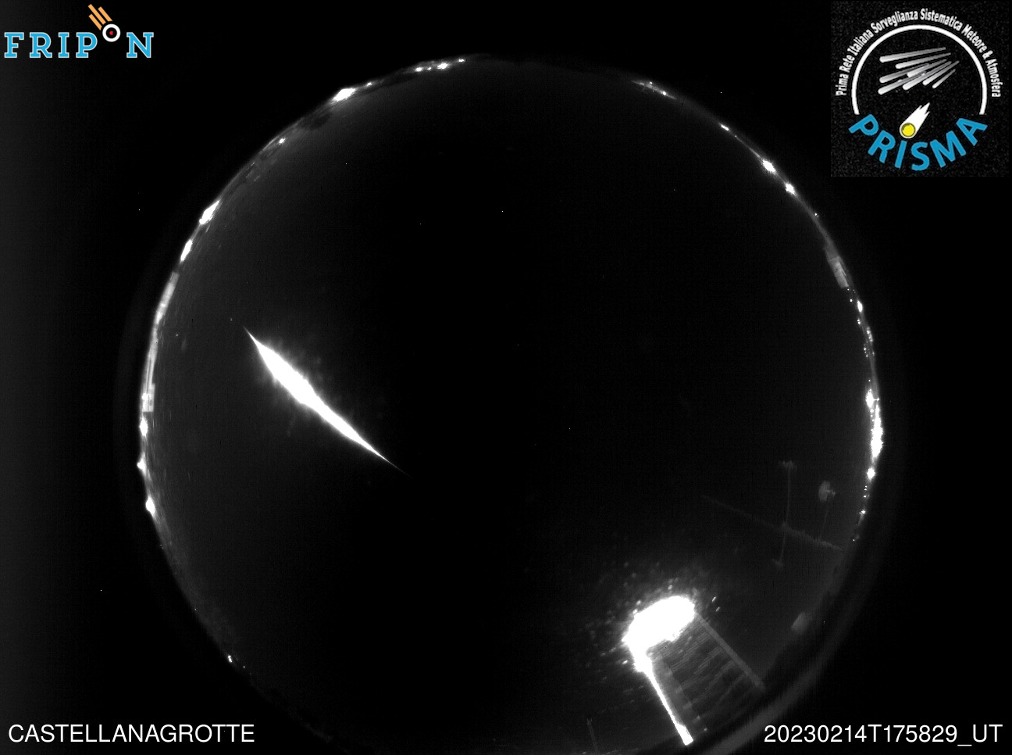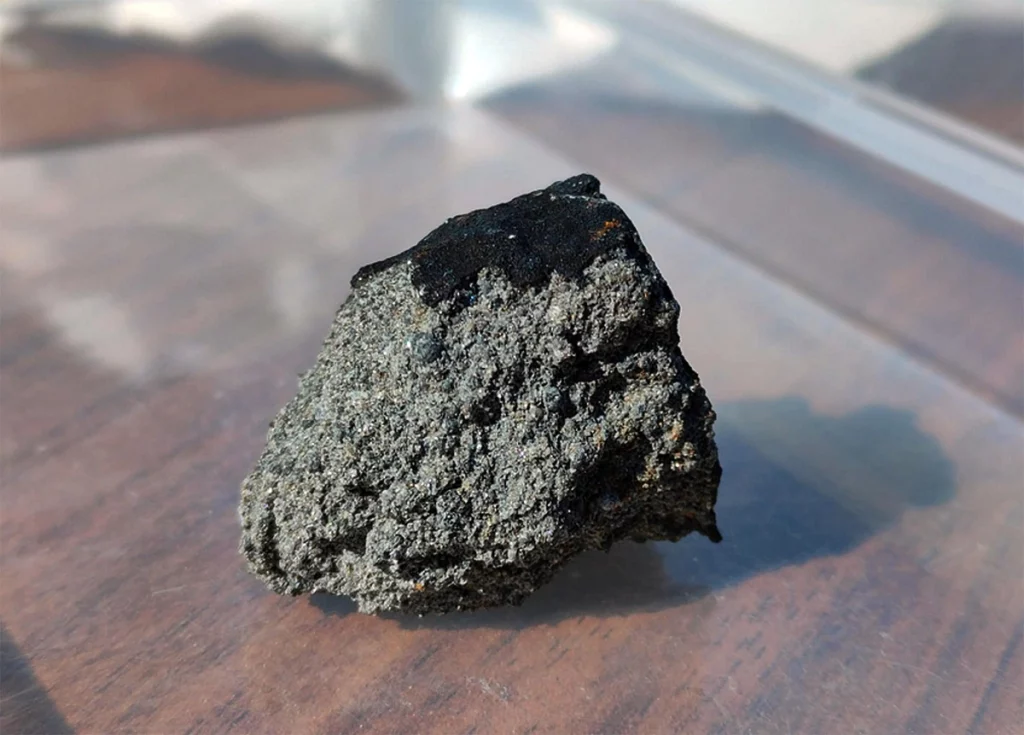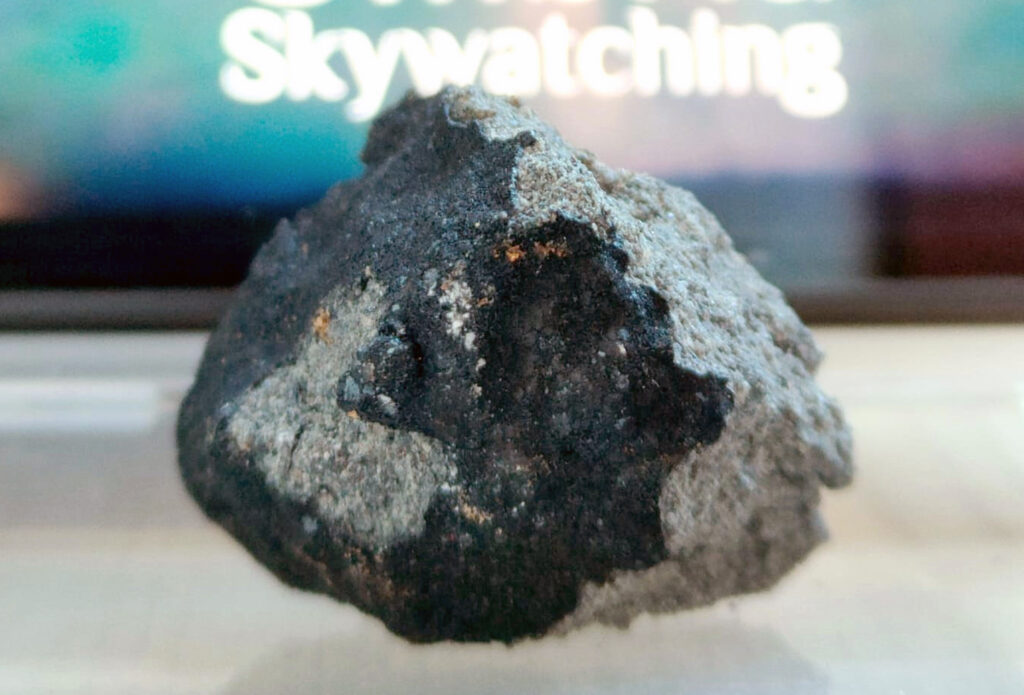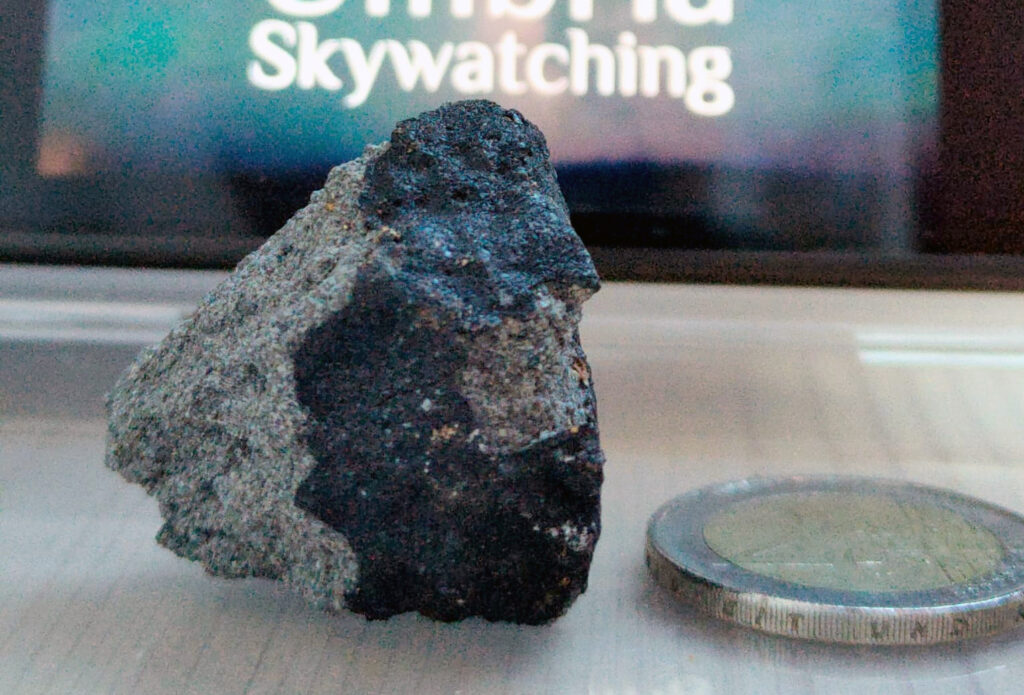MATERA meteorite fall (117.5 g, H5, S1) at 18:58:30 UT on 14 February 2023 in Matera, Basilikata, Italy
Last update: 15 February 2024
The meteorite (117.5 g, H5), in 12 larger and dozens of smaller fragments (milligrams to 2-3 grams)) was found on the balcony of the upper floor of the home of Gianfranco and Pino Losignore’s parents at location 40°41’43.8″N 16°35’04.0″E in the northern suburb of Matera. The first fragment of the meteorite was discovered while Pino Losignore was checking a malfunctioning solar panel on the balcony. After he had noticed an impact mark on the solar panel he found a 1.5-centimeter fragment and thought it could be a part of the meteorite fall in the area which he knew about because of PRISMA’s widely published fall zone map indicating a meteorite fall northwest of Matera. After that he found larger fragments further away from the impacted tile. He picked up all the fragments wearing gloves and then found Dr. Carmelo Falco ‘s contact data on the PRISMA website. Falco later found a second larger fragment and in the morning of 19 February Silvia Padilla and Pierluigi Cox of the Terni Amateur Astronomy Association found two smaller fragments with a magnet and a third larger specimen visually (found by Silvia) on the damp soil among the grass around the house . The largest found fragment weighs around 10 grams. Before the fall the Losignore brothers’ mother who was in the basement of the house had heard a loud bang coming from outside the house but ignored it because she thought it had been caused by a falling branch because of the strong wind outside. In the morning of 18 February 2023 the Losignore fragments were given to Dr. Falco, a representative of the Project Office of the PRISMA network and INAF associate. The bolide was recorded by the three PRISMA network cameras in Castellana Grotte, Tricase and Vasto, whose data were used by PRISMA’s Dario Barghini (INAF-OATo) and Albino Carbognani (INAF-OAS) in the afternoon of 15 February to calculate a first 8-square-kilometre meteorite fall zone map which was published by PRISMA on 16 February. The calculations were done by including the weather data (high altitude winds) calculated by Raffaele Salerno of Meteo Expert. According to PRISMA around 400-500 grams are expected to have fallen in the area. The found Losignore fragments might be brought to the INAF Science museums in Naples and Florence, together with the impacted tile. The mayor of Matera would also like to present some meteorite fragments in a museum of the Matera municipality in the future. On 20 February 2023 several found fragments were transported to the INFN Gran Sasso Laboratories where they arrived in the afternoon of the following day. There in the germanium detector of the STELLA (Subterranean Low-Level Assay) laboratory the meteorite’s cosmic ray exposure age will most likely be determined. The meteorite’s short-lived radioisotopes will probably also be analysed in order to determine the meteorite’s terrestrial age and thus its definitive connection to the bolide on 14 February 2023. On 20 February 2023 an INAF Prisma press conference on the fall was held in Matera. On 14 February 2024 the fall was officially recorded in the Meteoritical Bulletin as MATERA (H5, S1).
Congratulazioni al team PRISMA!
Innanzitutto tutti erano la ricerca di questo meteorite di questo San Valentino e invece il meteorite trovato noi.
(Mr. Losignore)

The fragments of the found meteorite. Photo: PRISMA/INAF
The fragments of the found meteorite. Photo: PRISMA/INAF

The fragments of the found meteorite lined up according to size. Photo: PRISMA/INAF

The impact dent on the balcony tile. Photo: PRISMA/INAF
The impact dent on the balcony stoneware tile. Photo: PRISMA/INAF
“Stava indicando un bellissimo frammento grande come una noce, che se ne stava lì nascosto tra le foglie con una fantastica crosta di fusione tipica dei meteoriti appena caduti. Penso di aver sentito il mio cuore fermarsi per qualche secondo, poi con le mani tremanti ho messo i guanti in vinile, per prendere delicatamente il frammento e inserirlo nella bustina di plastica.” (Silvia Padilla)

The fall location (green) within the strewn field calculated by Albino Carbognani (INAF-OAS) and Dario Barghini (INAF-OATo). Image: PRISMA/INAF

The first meteorite fall zone map calculated by Albino Carbognani (INAF-OAS) and Dario Barghini (INAF-OATo) and published on 16 February 2023. Image: PRISMA/INAF
The ‘San Valentino’ bolide
The bolide reached an absolute magnitude of -11. Its 5.4-second luminous trail was visible from an altitude of about 85.5 kilometres and had an angle of about 57° from the ground. The meteoroid’s initial speed when it hit the atmosphere was about 16.4 km/s. The luminous trail had its termination point at an altitude of about 23 km with a terminal speed of 3.8 km/s.
The bolide captured by the PRISMA camera near Castellana Grotte, ~51 km east-northeast of the fall location. Video: PRISMA/INAF

The bolide captured by the PRISMA camera near Castellana Grotte, ~51 km east-northeast of the fall location. Image: PRISMA/INAF
The bolide captured by Simone Auciello’s “Benevento Ciancelle” webcam, located in Contrada Ciancelle near location 41.118°N, 14.729°E, ~163.88 km west-northwest from a find location north of Matera.
Video: MeteOne
Video: Ivano Gravante
LINKS
Eccola! Trovata la meteorite di San Valentino! (by Daniele Gardiol, 18 February 2023)
La mappa della meteorite di San Valentino (16 February 2023)
Matera, è caccia alla “meteorite di San Valentino” (16 February 2023)
Media
Daniele Gardiol about the Matera meteorite fall (from 49.35 min. running time) in his talk PRISMA e il ritrovamento della meteorite di San Valentino (Caffè-Scienza Firenze, published 3 March 2023)
Interview with Daniele Gardiol, INAF astronomer from Turin and national coordinator of the PRISMA network of the National Institute of Astrophysics. (deejay, Il Boss Del Weekend (18 February 2023)
Interview with Carmelo Falco who explains the importance of the PRISMA network for finding scientifically important meteorites in Italy soon after their fall, Rai News, Mattina24 (20 February 2023)
Oggi è un altro giorno Meteorite di San Valentino, frammenti su un balcone di Matera (RAI, 22 February 2023)
Video: trmh 24 (18 February 2023)
Gianfranco Losignore talking about the meteorite fall on their house (Antenna Sud – canale 14, 23 Februray 2023)
Nei laboratori del Gran Sasso i frammenti del meteorite di San Valentino (TV report, TGR, 21 February 2023)
Conferenza stampa (Comune Matera) (20 February 2023)
Trovato il meteorite caduto a Matera (TV report, TGCOM, 18 February 2023)
La mappa della meteorite di San Valentino (PRISMA, 16 February 2023)






































